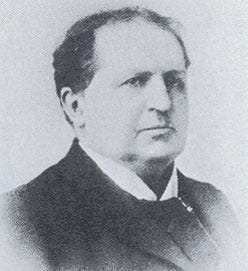Neo-Calvinism Defined (A Little History Lesson)
The most read post I've ever written, rewritten and re-posted here at Substack.
For the past two decades, there has been a lot of discussion about the rise of the “New Calvinists” or the “Young, Restless, and Reformed” (so titled since Collin Hansen wrote about the movement in his 2006 article in Christianity Today and the follow-up book two years later).
Nathan A. Finn provided this description at The Gospel Coalition of this group:
It’s an informal network of conservative evangelicals who frequent this website, attend conferences like Together for the Gospel, listen to podcasts by Matt Chandler and Al Mohler, read books written by John Piper and Tim Keller, and appreciate Edwards and the Puritans.
Brad Vermurlen, author of Reformed Resurgence: The New Calvinist Movement and the Battle Over American Evangelicalism, (Oxford University Press, 2020) told Colin Hansen on the Gospelbound podcast,
When I did talk to people about what I was doing, at least the people who were familiar with American religion, there was some confusion when I said New Calvinism, some people thought I meant the Kuyperian style, Neo-Calvinism of the mid-century. And I had to explain, no, this is actually, it’s a related movement, but it’s different. It’s a different thing going on. It’s something that’s arisen just in the last 20 years or so and it involves different people. So there was that confusion with Kuyperian neo-Calvinism.
I Know Neo-Calvinism, and that’s not Neo-Calvinism
I think these New Calvinists should not be called “Neo-Calvinists,” but rather “Neo-Puriatans.”
Back in 2009, in response to Time Magazine misusing the term Neo-Calvinism, I wrote a series of posts on my old blog Vanguard Church on the nuanced differences between Neo-Puritanism and Neo-Calvinism.
Scot McKnight picked up on this terminology as he has interacted with people over the years. In a comment on a blog post by David Fitch in which Fitch was critiquing New Calvinist Mark Driscoll, Scot wrote,
“A former student of mine, Bob Robinson, told me a few years back that he had read a careful church historian who thought NeoPuritanism was more accurate. Jamie Smith also pushed back against using the term Reformed for this group; Vince Bacote thinks NeoCalvinist is not fair to Kuyper; Ken Stewart’s book proved to me again the Reformed movement is too big for this new development of mostly Baptist Calvinists…
…So there is some protection of terms here and I have now myself landed on NeoPuritan as the heart of this movement. Puritanism is, of course, personal zeal before the Lord for holiness and, also, zeal for reforming church and society according to biblical (and not ecclesiastical) teachings. So I agree, we should probably start using NeoPuritan.”
Brad Vermurlen’s experience is that people still get confused (as David Fitch did) about “Neo-Calvinism.” It seems that people need to understand that the terms “Calvinist” or “Reformed” are much broader terms than any one particular group. We also need to make it clear that there is another group of Calvinists, a group that has called themselves “Neo-Calvinist” for over 100 years, and has also gained some prominence in North America recently. This group has similarities to the “Young, Restless, and Reformed” Calvinists, but there are some marked distinctions.
The Emphases of Neo-Puritanism
Like Scot McKnight, I think that the one group (the Young, Restless, and Reformed group) should be seen as Neo-Puritanism.
This new group gets their cues from the old Puritans. For instance, Baptist John Piper takes great joy (literally) from the teachings of Jonathan Edwards.
While there are Presbyterians, the weight of the movement is with Baptists like John Piper, D.A. Carson, and Albert Mohler, who is the president of The Southern Baptist Theological Seminary.
Neo-Puritanism appropriately enlarges our view of God’s authority and thus our view of evangelism, worship, and the church’s role in society. It is very concerned with theological issues like the reality of sin and its destruction to both individuals and society. It emphasizes Penal Substitutionary Atonement and Justification as the means for individuals to be saved. And the Five Points of Calvinism (“TULIP”) are important topics of discussion. The main leaders are pastors with large media platforms and book deals (like John Piper, David Platt, and Kevin DeYoung).
Neo-Puritanism sees the answer to society’s woes as starting with personal piety and then it moves out toward society, seeking to influence the culture to live by the pious standards in which Christians live. It is very active in the religious and cultural clashes in today’s American society, especially the issues of gay marriage and abortion.
But this is not Neo-Calvinism, which has different emphases.
The Emphases of Neo-Calvinism
Neo-Calvinism dates back to Abraham Kuyper, the 19th Century Dutch cultural leader who famously said, “There is not a square inch in the whole domain of human existence over which Christ, who is sovereign over all, does not cry, ‘Mine!’”
“Grace restoring nature” is the central insight of Neo-Calvinism (as Albert Wolters says in his seminal book, Creation Regained: Biblical Basics for a Reformational Worldview (Eerdmans, 1985, 2nd ed. 2005).
In other words, God has made a good creation that he loves with norms and God-given potential, with humanity as the pinnacle and the rulers/stewards for the sake of each other and the non-human creation. The rebellion of humanity through sin from this mandate has given rise to a broken world. But Christ’s work on the cross brings reconciliation of all things back to God, including every aspect of human life. God’s intention is to restore the shalom of the original creation, thus he inaugurated the kingdom of God through the death and resurrection of Jesus Christ. This redemption of humanity, and thus the entire cosmos, will come to its consummation when God restores everything in the New Heavens and New Earth. Thus, the gospel message for the Neo-Calvinists is best summarized by four chapters – Creation, Fall, Redemption, and Consummation.
This is where neo-Calvinists differentiate themselves from the Neo-Puritans:
They insist that there has not been enough attention paid to the first and last chapters (“Creation” and “Consummation”). Acknowledging that the cross is the climax of Redemption’s story, neo-Calvinists insist that focusing just on Fall and Redemption (i.e., personal sin and salvation) neglects the deep implications of the cross to the cosmic story of God’s redemptive plan.
While both Neo-Calvinism and Neo-Puritanism are concerned about personal piety and cultural influence, they come at these things from different angles. Neo-Puritanism focuses on “the sovereignty of God in salvation.” Neo-Calvinism focuses on “the sovereignty of God over creation.” Their Calvinism has a ‘changing the world’ comprehensiveness, seeking the redemption found in Christ infiltrating all spheres of society through the loving influence of Christians doing their day-to-day work in every facet of society. The emphasis is less on pastors and their work and more on laypeople and their work.
Ray Pennings, Executive Vice President of the Neo-Calvinist think tank Cardus, wrote an excellent piece entitled, “Can we hope for a neocalvinist-neopuritan dialogue?: Forging a public theology relevant for our times.” In that article, he offered this insightful nuance:
“Neo-Puritanism is slanted more towards individual piety and churchly revival, and Neo-Calvinism is slanted more towards corporate activism and cultural renewal.”
In a discussion I had with Ray Pennings, I asked him to expand on the important distinctions of Neo-Calvinism. He told me,
“I find the Neo-Puritanism / Neo-Calvinism distinction to be more helpful. There is a profound difference in their approach to the gospel. Neo-Puritans focus on the personal nature of salvation and see the church as primarily a salvation-factory, the workshop of the Holy Spirit in which the Word is sovereignly applied to the hearts of the totally depraved and they are brought into a vital relationship with God. The meaning of this for the rest of life is understood to be secondary and a by-product of a faithful life which has the church and the covenant community as its primary focus.
Neo-Calvinists on the other hand, focus on the church as the recharging station for the people of God and focus on the work of the spirit taking the witness of God’s people into their everyday lives. In practical terms, preaching and church life focuses on equipping the people of God for their comprehensive callings.”
Two Streams of Calvinism
Now, I must emphasize that these are two streams of the same theology, Calvinism. Therefore, there is certainly overlap. While The Gospel Coalition has become much more vocal about a Neo-Puritan agenda, they have just launched The Keller Center, which honors the late Tim Keller and his Kuyperian Neo-Calvinism.
On the other hand, a prominent neo-Calvinist college ministry conference, Jubilee, not only addresses God’s intention of restoring the original intentions and the materiality of God’s good creation with speakers like Eric Mason, J. Richard Middleton, and Andy Crouch, but also proclaims the means of salvation and the importance of personal piety with speakers like Jon Tyson and John Mark Comer.
As Ray Pennings told me,
“As with any bi-modal contrast, the differences here are highlighted in a way that might obscure the fact that many would reject these labels as reinforcing an either-or approach when a ‘both-and’ is more appropriate.
Nonetheless, any careful observer of the church and cultural life of those associated with these different groups should recognize that this debate has real every-day consequences.
The character of preaching, the priorities in personal and church life, and the engagement with society and culture does look different depending on how one approaches these issues, making “Neo-Puritanism” and “Neo-Calvinism” descriptive terms that should be used in a helpful way to understand the contemporary Reformed and Presbyterian scene.”
Click on the image below for a link to a pdf chart that sums up what these nuances look like by providing representative examples.







